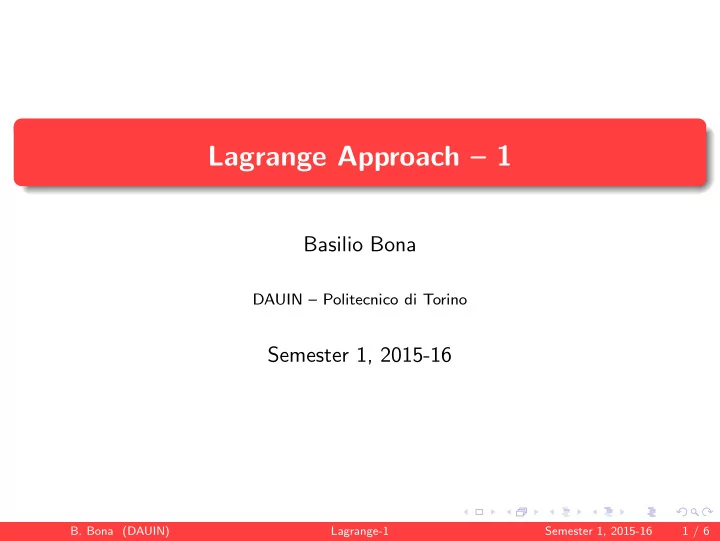

Lagrange Approach – 1 Basilio Bona DAUIN – Politecnico di Torino Semester 1, 2015-16 B. Bona (DAUIN) Lagrange-1 Semester 1, 2015-16 1 / 6
Initial steps Find the k = 1 , . . . , N rigid bodies composing the system and compute the n degrees-of-freedom. If necessary, define the various body frames R k Define a set of complete and independent generalized coordinates q i ( t ) , i = 1 , . . . , n ≤ 6 N Compute the position vectors of each center-of mass p k ( q ( t )) , k = 1 , . . . , N Compute the linear velocity vectors of each center-of mass v c , k ( q ( t ) , ˙ q ( t )) and the angular velocities vectors ω k ( q ( t ) , ˙ q ( t )) of each body B. Bona (DAUIN) Lagrange-1 Semester 1, 2015-16 2 / 6
Energy computation Compute the kinetic co-energy K ∗ k of each k -th rigid body with mass m k and inertia matrix (wrt the center-of-mass) Γ k as k = 1 2 m k � v c , k � 2 + 1 2 ω T K ∗ k Γ k ω k Set the local gravity acceleration vector g and represent it in R 0 Localize the N e elastic energy storage elements and model them with “ideal springs” with elastic constants k ℓ , ℓ = 1 , . . . , N e Compute the gravitational potential energy P g , k and the elastic energy P e ,ℓ as P e ,ℓ = 1 2 k ℓ � e � 2 P g , k = − m k g T p k where e is the elongation (positive or negative) of the spring. B. Bona (DAUIN) Lagrange-1 Semester 1, 2015-16 3 / 6
Lagrangian function Compute the total energies N N N e � � � K ∗ ( q , ˙ q ) = K ∗ P ( q ) = P g , k + P e ,ℓ k k =1 k =1 ℓ =1 Compute the Lagrange function of the system L = K ∗ − P Compute the generalized forces F i Write the n Lagrange equations � ∂ L d � − ∂ L = F i i = 1 , . . . , n d t ∂ ˙ q i ∂ q i i.e., d � ∂ K ∗ � − ∂ K ∗ + ∂ P = F i i = 1 , . . . , n d t ∂ ˙ q i ∂ q i ∂ q i B. Bona (DAUIN) Lagrange-1 Semester 1, 2015-16 4 / 6
Lagrange equations If there are linear dissipative elements, model them with a linear dashpot, having friction coefficient β i . Compute the dissipative function D i = 1 2 β i � v f , i � 2 , where v f , i is the velocity associated to the friction producing element. Upgrade the Lagrange equations as follows � ∂ K ∗ � − ∂ K ∗ + ∂ P + ∂ D d = F i i = 1 , . . . , n ∂ ˙ ∂ ˙ d t q i ∂ q i ∂ q i q i What happens when nonlinear elastic or friction elements are present? One should directly introduce the resulting nonlinear elastic or friction forces in the Lagrange equations. B. Bona (DAUIN) Lagrange-1 Semester 1, 2015-16 5 / 6
Advanced material Part 2 will introduce advanced material B. Bona (DAUIN) Lagrange-1 Semester 1, 2015-16 6 / 6
Recommend
More recommend